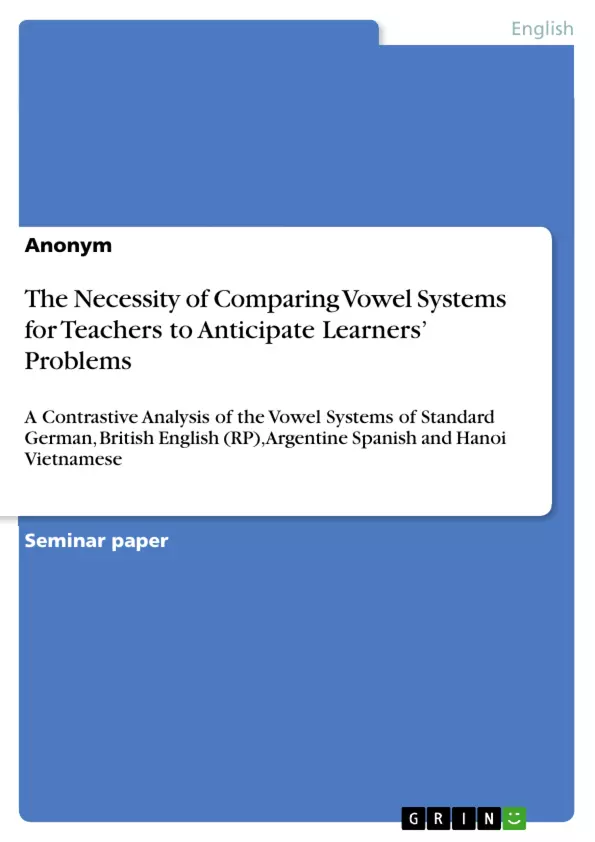This paper argues that understanding and comparing the vowel systems of the native (L1) as well as the target language (L2) is a necessity for language instructors to anticipate problems that will most definitely occur in the classroom as well as to develop strategies to deal with those difficulties. In order to demonstrate how much the vowel systems of the languages of the world can actually differ from each other, the vowel inventories of four different languages which differ in several phonetic parameters will be analysed and discussed with regard to the problems that might occur due to those differences.
Inhaltsverzeichnis (Table of Contents)
- Introduction
- Vowel Classification
- Monophthongs
- Quality
- Quantity
- Diphthongs
- Monophthongs
- Cross-Language Phonetic Similarities of Vowel Systems
- Vowel System Inventories of Some of the World’s Languages
- Standard German
- British English (Received Pronunciation)
- Argentine Spanish
- Hanoi Vietnamese
- Contrastive Analysis and Consequential Problems for Learners
- Quantity as a Contrastive Parameter
- Contrastive Vowel Qualities
- The Co-Occurrence of Different Phonetic Parameters
- Diphthongs
Zielsetzung und Themenschwerpunkte (Objectives and Key Themes)
This paper argues that understanding and comparing the vowel systems of the native (L1) as well as the target language (L2) is a necessity for language instructors to anticipate problems that will most definitely occur in the classroom as well as to develop strategies to deal with those difficulties.
- The importance of contrastive analysis for language teaching
- The phonetic differences between various vowel systems
- The potential difficulties faced by learners in acquiring new vowel sounds
- The need for teachers to develop strategies to address learners’ vowel pronunciation issues
- The role of linguistic experience in vowel perception and production
Zusammenfassung der Kapitel (Chapter Summaries)
This paper examines the vowel system inventories of four languages: Standard German, British English (Received Pronunciation), Argentine Spanish, and Hanoi Vietnamese. The analysis focuses on identifying the main phonetic differences between the languages and considering the challenges these differences pose for language learners.
Chapter 2 provides a theoretical framework for understanding vowel classification by defining and illustrating the parameters of quality and quantity. It distinguishes between monophthongs and diphthongs and explains the different types of diphthongs found in the languages of the world.
Chapter 3 explores cross-language phonetic similarities in vowel systems, drawing on insights from the UCLA Phonological Segment Inventory Database (UPSID) to demonstrate the regularities that exist across languages. It analyzes the distribution and frequency of different vowel qualities and explains the acoustic properties of the most common vowels.
Chapters 4.1-4.4 present detailed descriptions of the vowel system inventories of the four chosen languages, highlighting their key characteristics and contrasting them with each other. For example, Standard German is shown to have a relatively large vowel inventory with a complex system of tense and lax vowels, whereas Argentine Spanish has a smaller inventory with a greater emphasis on diphthongs.
Chapter 5 delves into the challenges faced by learners when acquiring vowel sounds in a foreign language. It examines the difficulties arising from contrastive length, vowel qualities, and the co-occurrence of rare phonetic parameters. It also analyzes the difficulties associated with learning diphthongs and the impact of linguistic experience on vowel perception and production.
Schlüsselwörter (Keywords)
This paper focuses on contrastive analysis, vowel systems, phonetics, language teaching, learner difficulties, vowel perception, vowel production, linguistic experience, and the challenges of acquiring a foreign language.
- Quote paper
- Anonym (Author), 2021, The Necessity of Comparing Vowel Systems for Teachers to Anticipate Learners’ Problems, Munich, GRIN Verlag, https://www.grin.com/document/1035035



